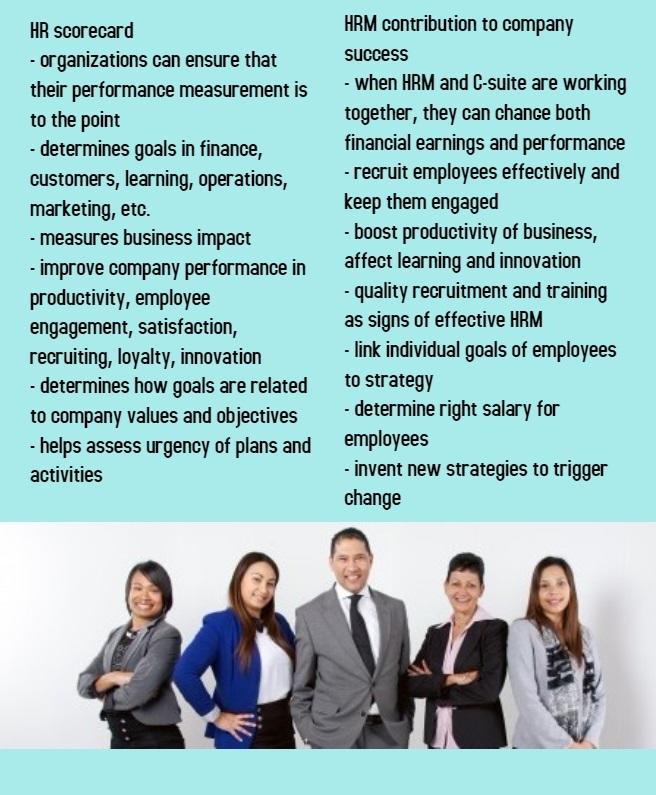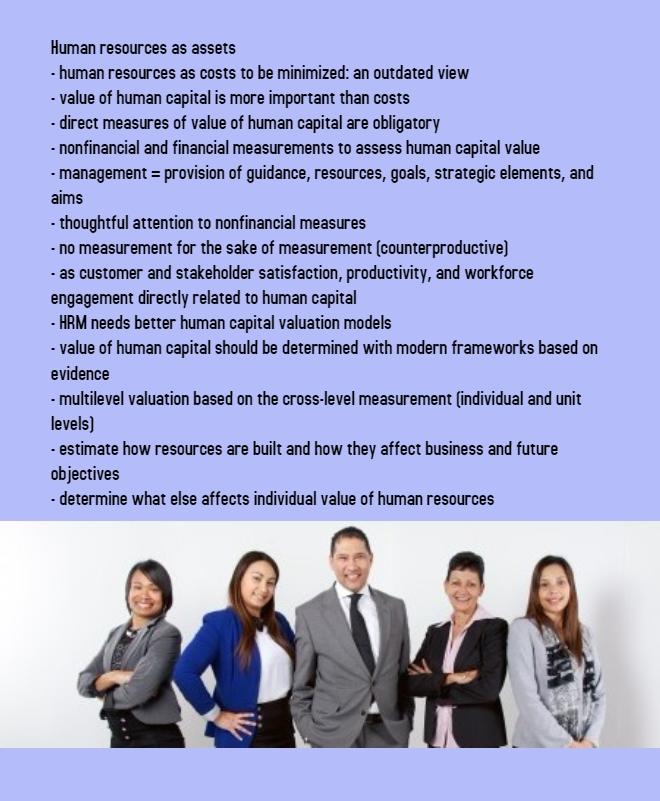With the help of an HR scorecard, the organization can ensure that its performance measurement is more to the point and accurate than previously. This happens because the HR scorecard ensures that goals in various areas (such as finance, customers, learning, operations, etc.) are well-defined and easy to follow and determine (Shree Balaji Management Consultants, 2014). Well-defined metrics that can measure business impact, as well as other areas of interest of managers, have great potential in improving the overall company performance in productivity, employee engagement, satisfaction, recruiting, and retention (AdeccoGroup, 2011; Bruce, 2008). It is also highly helpful to the HRM because it assists the HR manager in determining how the company’s vision and mission can be translated into concrete metrics, which indicate how and with which methods this or that goal can be accomplished. The HR scorecard can also indicate what aims and plans are more urgent and how they will affect the organization in general.
The difference between the two factors is that the first factor (how can HRM contribute to the success) targets strategies and decisions that are not implemented yet but can potentially be extremely beneficial. For example, if HRM and C-suite are working together, there is a higher chance that both financial earnings and performance can be enhanced through this collaboration (Starz, 2016). Another opportunity is the efficiency of the HRM; if it can recruit employees effectively and keep them engaged, it will both boost the productivity of the business and learning and innovation in the organization as well (“How can HR manager contribute to business success”, n.d.). Measurement and training of employees are the responsibilities of HRM but if they should be well-conducted to ensure that HRM is indeed contributing to the success of the organization. If the HR manager is ready to understand the business of the company and works as a partner rather than a manager, he or she can also enhance the company’s success (ASUGtv, 2013).
Human Resources as Assets
The view of human resources as costs that need to be minimized has practically ceased to exist. Fulmer and Ployhart (2014) point out that even though other metrics (both financial and non-financial) are used today in HRM to measure human capital and its performance and influence on the overall productivity, there are still not enough direct measures of the value of human capital that both organizations and stakeholders could use. I agree that the view of human resources as costs that are to be minimized is a rare one, but the management of human assets can be still difficult because mostly the following indirect measures are used: “internal evaluation of managers and evaluation of organizations by external stakeholders” (Fulmer & Ployhart, 2014, p. 181). Successful management of human resources implies that they are provided with needed guidance, resources, goals, strategic elements, and aims rather than be measured just for the sake of measurement. Fulmer and Ployhart (2014) notice that thoughtful attention to nonfinancial measures is preferred over the determinacy to create metrics that would apply to these measures. I believe that minimizing human resources is a dead end because some vital metrics such as customer and stakeholder satisfaction, productivity, and workforce engagement can either support or shake the effectiveness and success of a company. Indeed, organizations need better human capital valuation models that are based both on individual and unit levels; there is no need to return to the perception of human resources as costs because it would have a disadvantageous impact both on organizational processes and the organization itself.
Memo
HR scorecard
- organizations can ensure that their performance measurement is to the point
- determines goals in finance, customers, learning, operations, marketing, etc.
- measures business impact
- improve company performance in productivity, employee engagement, satisfaction, recruiting, loyalty, innovation
- determines how goals are related to company values and objectives
- helps assess the urgency of plans and activities
HRM contribution to company success
- when HRM and C-suite are working together, they can change both financial earnings and performance
- recruit employees effectively and keep them engaged
- boost productivity of the business, affect learning and innovation
- quality recruitment and training as signs of effective HRM
- link individual goals of employees to strategy
- determine the right salary for employees
- invent new strategies to trigger a change
Human resources as assets
- human resources as costs to be minimized: an outdated view
- value of human capital is more important than costs
- direct measures of the value of human capital are obligatory
- nonfinancial and financial measurements to assess the human capital value
- management = provision of guidance, resources, goals, strategic elements, and aims
- thoughtful attention to nonfinancial measures
- no measurement for the sake of measurement (counterproductive)
- as customer and stakeholder satisfaction, productivity, and workforce engagement directly related to human capital
- HRM needs better human capital valuation models
- value of human capital should be determined with modern frameworks based on evidence
- multilevel valuation based on the cross-level measurement (individual and unit levels)
- estimate how resources are built and how they affect business and future objectives
- determine what else affects the individual value of human resources


References
AdeccoGroup. (2011). The power of HR metrics: Growth, performance, sustainment. Web.
ASUGtv. (2013). How HR can be a business partner. Web.
Bruce, S. (2008). HR metrics: Two common errors that make them worthless. Web.
Fulmer, I. S., & Ployhart, R. E. (2014). “Our most important asset”: A multidisciplinary/multilevel review of human capital valuation for research and practice. Journal of Management, 40(1), 161-192.
How can HR manager contribute to business success? (n.d.). Web.
Shree Balaji Management Consultants. (2014). HR balanced scorecard lesson: SBMC. Web.
Starz, M. (2016). 3 reasons why HR is critical to your company’s success. Web.